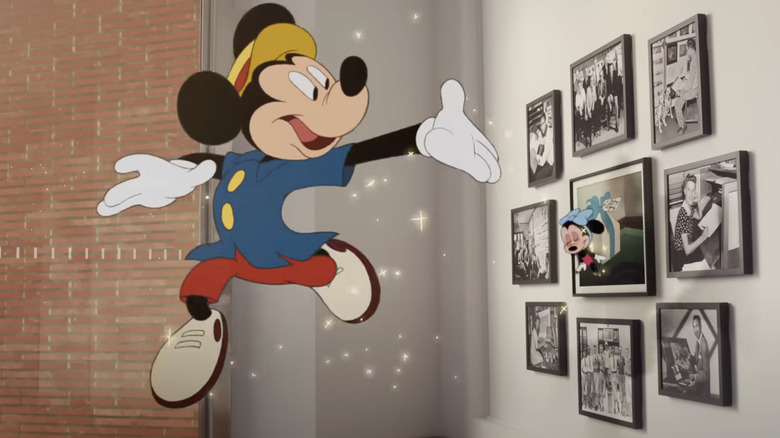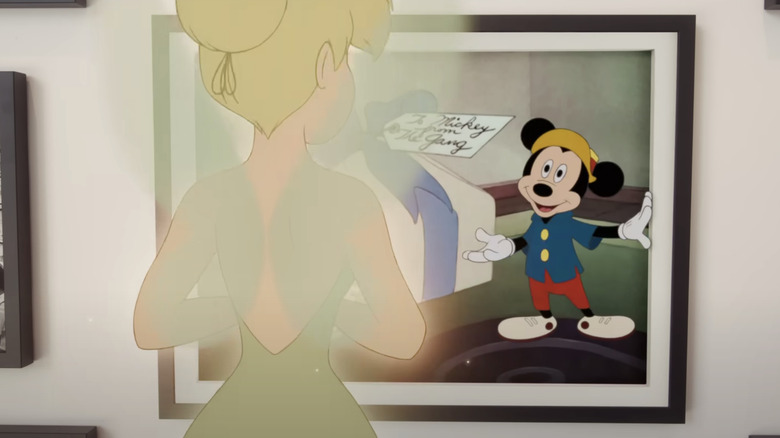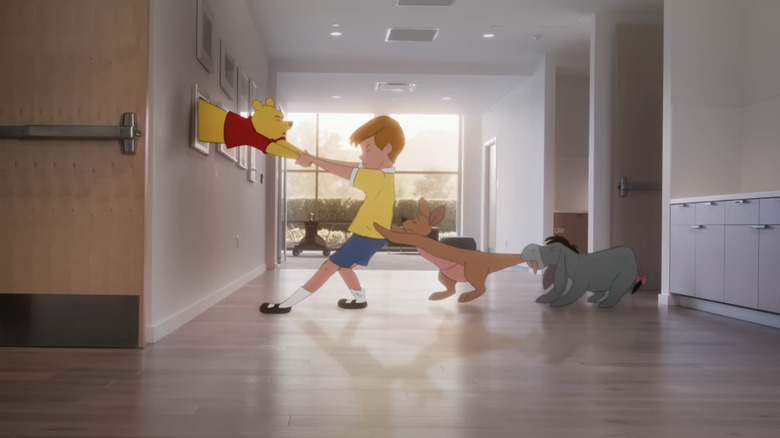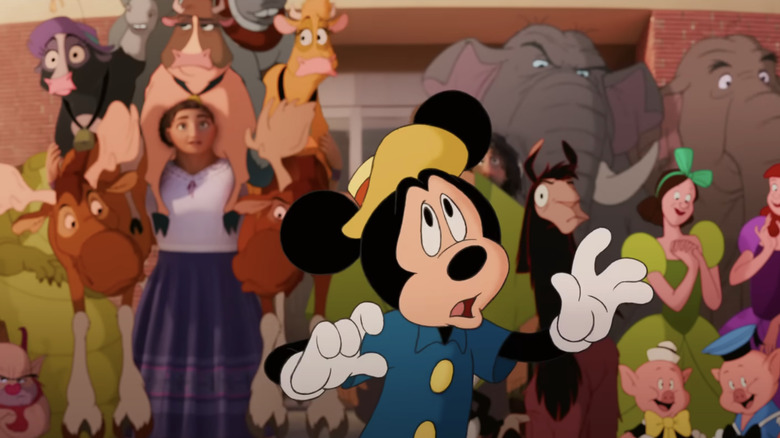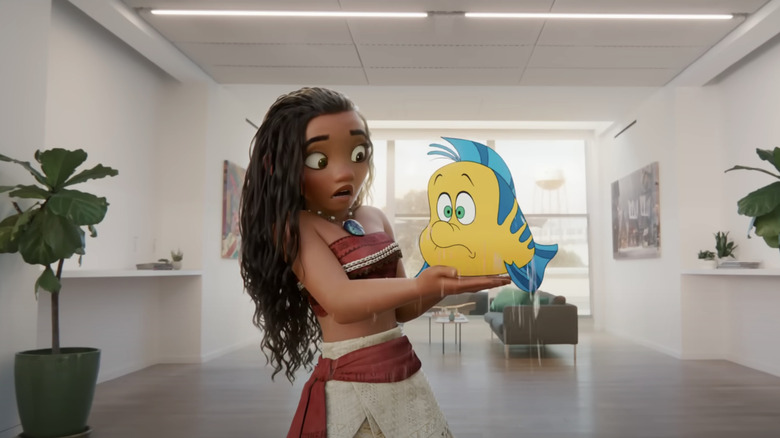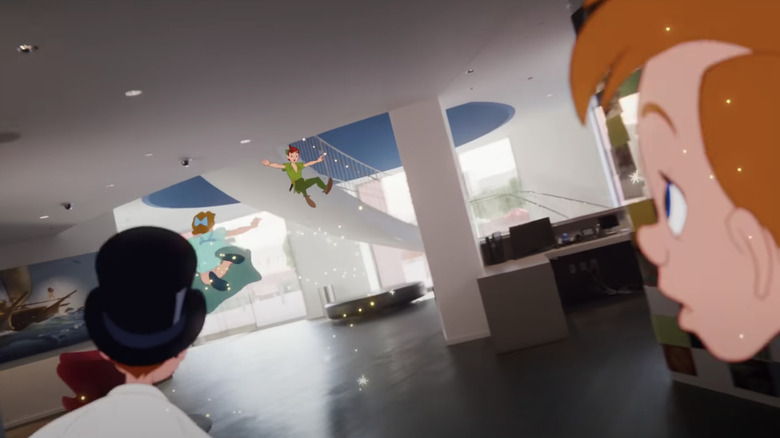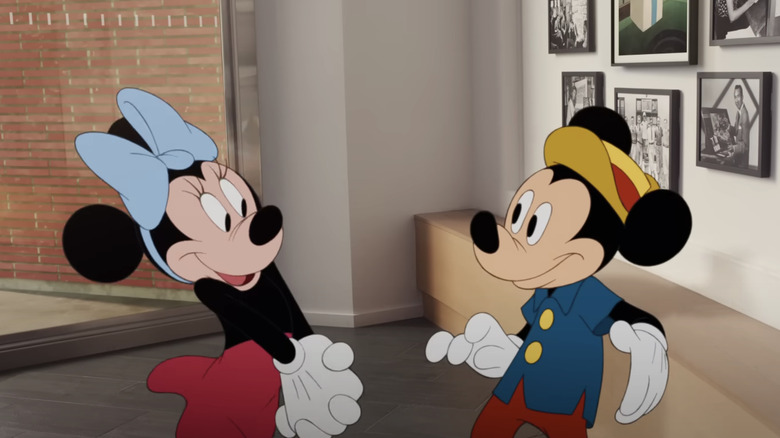Once Upon A Studio Directors On Making Us All Cry With Our Disney Faves [Exclusive Interview]
A few years back, Trent Correy and Dan Abraham looked to explore what happened to Olaf between the events of "Frozen" and "Frozen II" with their short film, "Once Upon a Snowman." Now, they're looking to show off what happens around the Walt Disney Animation Studios in Burbank, California after all of the animators have gone home for the night with "Once Upon a Studio." The short was developed as part of the centennial celebration of Walt Disney Animation, looking to honor 100 years of beloved characters, stories, and evolving animation techniques. It's practically impossible to succinctly encapsulate the impact, importance, and magic of Disney animation's first 100 years, but if there's anything that comes close, it's "Once Upon a Studio."
Featuring over 40 memorable voiceover artists, and characters from more than 85 Disney feature-length and short films, "Once Upon a Studio" is like a moving yearbook of Disney's past and present. Academy Award-winning composer and Disney Legend Richard Sherman even returned to Walt Disney's office to play "Feed the Birds" from "Mary Poppins" on piano as part of the score, and the late, great, Burny Mattinson (who worked at the studio for 70 years) makes a live-action appearance, forever immortalized along with 543 of his dearest animated pals. I recently joined Correy and Abraham over Zoom to discuss how the short came to be, and figure out how they feel about knowing they're about to be responsible for millions of people crying tears of joy all around the world.
Note: This interview has been lightly edited for clarity and brevity.
'There's a hundred different versions of Mickey'
The characters in your short are all represented through images throughout the animation studio. For someone who's never been there, is that where those images actually live, or did you have to do some redecorating?
Correy: Our studio is very well decorated with artwork everywhere. I mean, what you see in the short, there is artwork in those hallways. But we did do a lot of moving around, right, Dan, to get the right pieces?
Abraham: Yeah, in order to tell the story with the characters where we needed them to be, there was some choreography in moving some stuff around so that we could have these characters in this hallway, which would lead you to the next part and all of that. But some of it is where it is.
Correy: Yeah, and the cool thing about that, BJ, I know the [Animation Research Library] brought archived artwork to the El Capitan Theatre for you to see [for the press junket]. We worked with that team of ARL on the live-action shoot to move pieces around and bring in new pieces. So it was fun to kind of team up with them.
That's great to learn, especially because some of the characters wear the same outfit all the time, but then you have the main group. Like, Mickey has a hat on some days, or sometimes Goofy wears a different shirt. Are those images also ones that are on display at Disney Animation, or did you know you want specific versions of the characters?
Abraham: Yeah, I can speak to that. There's a hundred different versions of Mickey, right?
Right.
Abraham: And the way that we actually picked that was we knew we wanted our Walt [Disney] and Mickey moment. We knew that we wanted to sort of take a beat within all the chaos, and have a sentimental sort of homage to Walt. And we just landed on this idea of Mickey in front of the portrait. And I thought, "Wouldn't it be a nice visual to have Mickey remove his hat and put it on his heart?" And I thought, "Well, 'Mickey's Birthday Party,' 1942, he's got that cute little yellow hat and he's dressed nice and casual." It just really felt right. So we backed our Mickey up from that moment and decided that we were going to use Mickey, Minnie, Donald, Clarabelle, Horace, and Goofy, all from that short, based on Mickey's cute little yellow hat.
Correy: And those were fun conversations, right? Because it is not just the artwork on the walls, but what is Belle wearing? Is she wearing her gold dress or the white and blue? Is it human Kuzco or llama Kuzco? So they were really fun discussions to have.
'One person's deep cut is another person's passion'
I love that. I loved seeing Clarabelle, too. She's been having a moment lately because whoever plays her at one of the theme parks is really good. If you've never fallen down Disney TikTok to see the videos of Clarabelle dancing, I highly recommend it.
Correy: I know what I'm doing tonight! [laughs]
There are so many excellent deep cuts littered throughout, but I do need to confirm: Did I see my "Skeleton Dance" boys, or did I just want them to be there so bad that I hallucinated them?
Abraham: Oh, they're there. How could you not have the characters from the very first original "Silly Symphony?" [laughs]
I caught them out of the corner of my eye and I was like, "I don't know if this is my personal wish fulfillment or if they're actually here, so I'm going to confirm this when I talk to you." But what are your personal favorite deep cuts? I know that's subjective.
Correy: Well, I mean, and you're speaking to the last shot, BJ, which has like 543 characters in it. So obviously the Disney Library has thousands of characters, and we tried to get as much in as we could. I'm going to go with Ichabod Crane. [From 1949's "The Legend of Sleepy Hollow."]
Nice.
Correy: Just as a fun moment, as Dan and I were coming up with that moment, like, Ichabod is probably in our short, the most obscure character that gets the biggest close-up. I mean, he's big on-screen. He is alone before Goofy comes on the ladder. So that was a fun character to get in there.
Abraham: It is hard to say, because one person's deep cut is another person's passion and hero, and there are people out there that are thinking, "Ichabod deep cut? What are you talking about? I watch that every Halloween with my family. That's my favorite Disney, blah, blah, blah." So there's going to be those people on the other side of it. But yeah, there are probably not a lot of people who know who Johnny Fedora and Alice Blue Bonnet are, but they might know Spike the Bee. I mean we've got, what's his name from "Inner Workings," the short...
Correy: I think his name is Paul.
Abraham: Paul! So it depends on your generation and how obsessed you are with Disney like we are.
Correy: That's true. We even have George from "Paperman."
'Early on in our storyboards, we just littered every shot with a billion characters'
I feel like fandom with Disney can often be equated to the way people are with sports teams, where you have favorites that you're really hardcore about. So I felt secretly vindicated when I saw "Meet The Robinsons" very prominently because I love it, and I feel like that's one of those movies that people are like, "Oh, I never caught that one." And I'm like, "What do you mean you didn't see this one?!"
Abraham: That was huge for us, because you do still see Stitch all the time and Ariel and you see Cinderella, but there are people out there that love "Meet the Robinsons" or they love "Johnny Appleseed," and so we wanted to do our best to make you seen.
So you joked during the press panel that it was always like, "Oh, I just want one more character, one more character!" Who was the last one who made that final cut?
Correy: The last one that I can remember, is in the shot with Snow White, Asha, and Mulan. And when it pans down and Tigger pounces on Pooh, we added the White Rabbit [from "Alice in Wonderland"] in that one.
Abraham: Early on in our storyboards, we just littered every shot with a billion characters. And then when we got into production, we had to do a whole pass for complexity where we needed to pull some out in order to actually make this thing producible. But then as we went along, Trent and I kept trying to sneak certain ones back in. So the White Rabbit was in the original storyboards, but then at one point we had to take him out for complexity, but then in the last second we stuck him back in there.
I love that.
Abraham: And you know what? He was late. Right? He was late to the party.
It's thematically appropriate! You're keeping it very canonical here.
Abraham: That's right.
'Every single person said yes'
You've also got just an incredible roster of voiceover artists coming in for this to, in some instances, say, like, three words. How do you pitch this to that many people, many of whom are now huge deals?
Correy: Yeah, we had 40+ original voices cast. And yes, you're right. For some of them, Idina Menzel has two words. So how do you bring in a superstar like that and all she's saying is two words? It kind of felt like everyone was just happy to be involved because there are only so many little moments and we have this huge library to choose from. I think a lot of people were just excited to have a small part.
Abraham: Yeah. They sort of understood that even though it's a small part in the vast canon of Disney's hundred-year animation, their character got a line. And it didn't matter how small it was, it was a moment. That was the hard part of this — which characters get lines? We could have added hundreds and hundreds of characters to this thing that aren't on-screen. And that was tough because we're such big fans of all of it, and a lot of those secondary characters that we wish could also be on-screen, but we couldn't do it to make it producible.
Correy: And I mean, Dwayne Johnson's one of the biggest Hollywood stars, and he says four words, I think. So it's fun.
Abraham: But they were all into it. Everyone we reached out to, every single person said "Yes," and they came in and it was amazing.
How did the conversations differ when talking with a family's estate? There's a history with Robin Williams' estate and a need to be respectful of the way his voice is used. Was that one that you knew might be a harder get? Did you have a backup plan if the family said no?
Correy: I'll let Dan talk about the estate stuff. But really I have to say that we naively went into this project just with, "We're going to write parts for everyone and have all these characters." And we were kind of never steered which way to go or not. We just kind of made the short we wanted to make and didn't have to face that as directors creatively. But then, yeah, we absolutely went to Robin Williams' estate right away to get that cleared. And they were fully on board.
Abraham: Yeah, I mean, you have to in order to do something like this, it's not like you can just do what you want because then you're in for a world of hurt down the road. So we made sure very early on that we crossed all of our I's and dotted all of our T's.
On directing a legend
I love hearing that. So you also had the opportunity to direct the incomparable Burny Mattinson. How do you direct a legend? How do you even do that?
Abraham: Well, luckily he wasn't used to doing live-action and being an actor, even though, because he has been in story for close to 70 years, he's an actor. He's an actor with a pencil, for sure. So he had no problems. But he's our pal and mentor and just a lovely, humble, sweet guy. And getting him for this part was like — when we first started storyboarding this idea, drew Burny Mattinson walking down the hall with a young intern. Like, months before he even knew about the project, he was in the project. Because you could not tell the story without him.
Correy: Yeah. And I swear to you, BJ, when he says those lines at the door, that twinkle in his eye, I mean, that is just genuine Burny. There's no visual effects to get that twinkle. He's just that guy. I think he's just — everything comes from the heart for Burny.
Abraham: He's seen it all. The changes within the studio in 70 years, that is a lot of changes and regimes and the death of Walt and this one coming in and that one going out. 2D animation, hand-drawn animation, sort of going away and CG coming in. Like, he has seen it all. And to see that twinkle in his eye and that smile on his face, it's all worth it. It's all worth it. All those bumps in the road, all those times that the studio might've closed for whatever reason, and this and that, and weathering the storm, like Burny's seen it all, man.
'There were tears during production all the time'
I have time for one last question, and it's going to be another crying question cause it's what I do: It's one thing to see all of us press in a room sobbing, but this is going to be seen by millions of people all at once on television and they all have a social media account. Are you prepared for millions of people to just be like, #ImCrying all at the same time, and to know that it's your fault, that you did this? [laughs]
Correy: Oh, that's the best question.
Abraham: But it's a good cry.
It is.
Abraham: Hopefully it's all from joy, because what this whole thing is about is just bringing joy to people for eight and a half minutes and hopefully reuniting them with their friends again. That's what this is. And we feel so honored that we were able to spearhead this and direct it and bring it to the world, because it's meant the world to us.
Correy: And by the way, we're right there with you, because there were tears during production all the time. You mention Burny or Richard Sherman, or just seeing some of the animation in dailies. I mean, there were tears there. And I think this short came from such a genuine place, and us and the team put so much work into it was — at Annecy was our first showing of it out in the public eye. And we got this wonderfully warm standing ovation. And Dan and I wept on stage, you know? Because you just do your best to make these things connect with people. And when you see it connect in that way, it's very special.
"Once Upon a Studio" will debut on ABC during their "The Wonderful World of Disney: Disney's 100th Anniversary Celebration" special on October 15, 2023.
